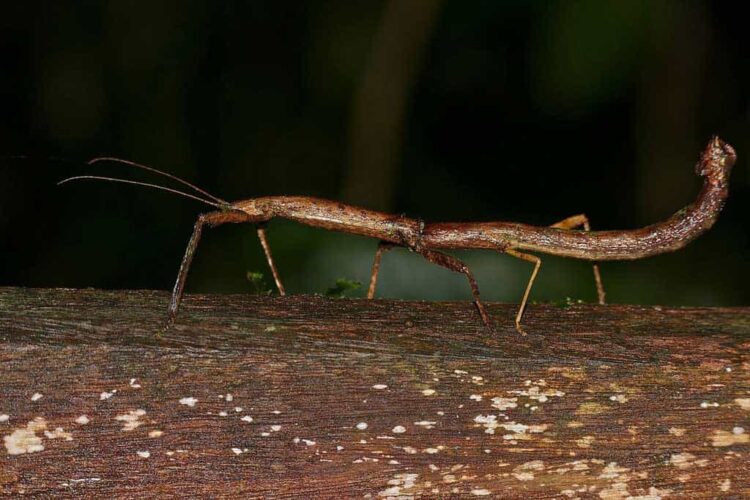Table of Contents
Stick insects make great pets for children as they are so easy to look after, do not smell, and do not require a massive amount of responsibility on the part of the child. They will, however, teach children what is involved in taking care of another creature and so are the perfect option before allowing them to take care of more high maintenance pets such as a rabbit, hamster, cat, or dog.
Nevertheless, there are those with no prior experience of stick insects that worry about stick insects being poisonous. Indeed, it is a question on the minds of many parents considering a stick as a pet for their kids.
Stick insects are not poisonous to humans and pose no danger to us. Some species of stick insect do, though, have a venom-like substance that is used to ward off predators. They do this by directing a spray at their attacker.
For a wealth of advice and information on all things stick insects, check out my ebook by clicking here or on either of the images (all open in a new tab). All your stick insect questions covered for just $2.99 (or the equivalent in your currency)!
or on either of the images (all open in a new tab). All your stick insect questions covered for just $2.99 (or the equivalent in your currency)!
So Which Stick Insect Makes the Best Pet?
If you are new to the world of stick insects, you might not be aware that there are actually around 3,000 different types of stick and leaf insect species. However, while experienced stick insect owners might be keen to take care of the more exotic species, new owners will usually start with the Indian stick insect
species. However, while experienced stick insect owners might be keen to take care of the more exotic species, new owners will usually start with the Indian stick insect , which is considered the easiest to look after.
, which is considered the easiest to look after.
The Indian stick insect is also known as the laboratory stick insect or by its scientific name Carausius morosus. It grows to between eight and ten centimetres long and is a green or dark brown colour with red patches on its front legs. The majority of Indian stick insects are female; indeed, the female is capable of laying eggs that hatch into female nymphs without these eggs being fertilised by a male of the species.
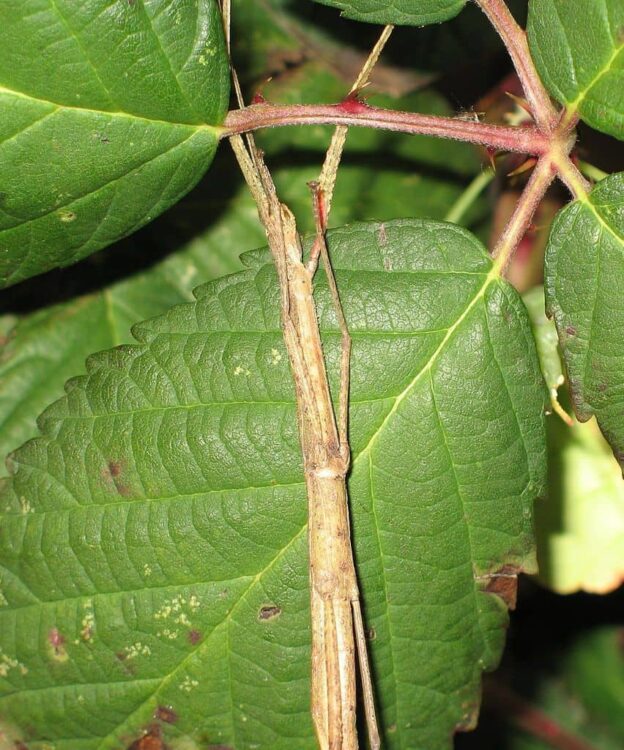
You may have been wondering if stick insects are poisonous, but know that an Indian stick insect protects itself by becoming rigid in the hope that predators see it as nothing more than a stick or twig (hence the name).
When Indian stick insects feel threatened, they may feign death or sway from side to side, giving the impression of a twig blowing in the breeze. Indian stick insects are nocturnal , like most stick insects. This means that they are active at night, which is the time they feed. During the day, they tend to rest in one place.
, like most stick insects. This means that they are active at night, which is the time they feed. During the day, they tend to rest in one place.
The Indian stick insect is an easy species to take care of and feeds mostly on fresh leaves. Their preferred choice is bramble, privet, and ivy leaves, but they also eat hawthorn, oak, and rose leaves as well.
as well.
Other Types of Stick Insect
If you are looking for a stick insect that is larger and more exotic looking than the Indian stick insect, you will be pleased to know that there are certainly many species to choose from. Some of these can be quite large and will therefore require more maintenance. Furthermore, you should know that the more exotic the species, the more likely it is that they will have more advanced defence mechanisms. This often makes them unsuitable as pets for children. The following are a few examples of some stick insect species and how they protect themselves from danger.
from danger.
Giant Prickly Stick Insect
The giant prickly stick insect is also known as Macleay’s Spectre or Extatosoma tiaratum. It hails from Australia and, like the Indian stick insect, can reproduce without the need of a male. The giant prickly stick insect varies in colour from green, to brown, to red and white. The male of the species is smaller than the female at around 9cm, whereas the female can grow to about 20cm.
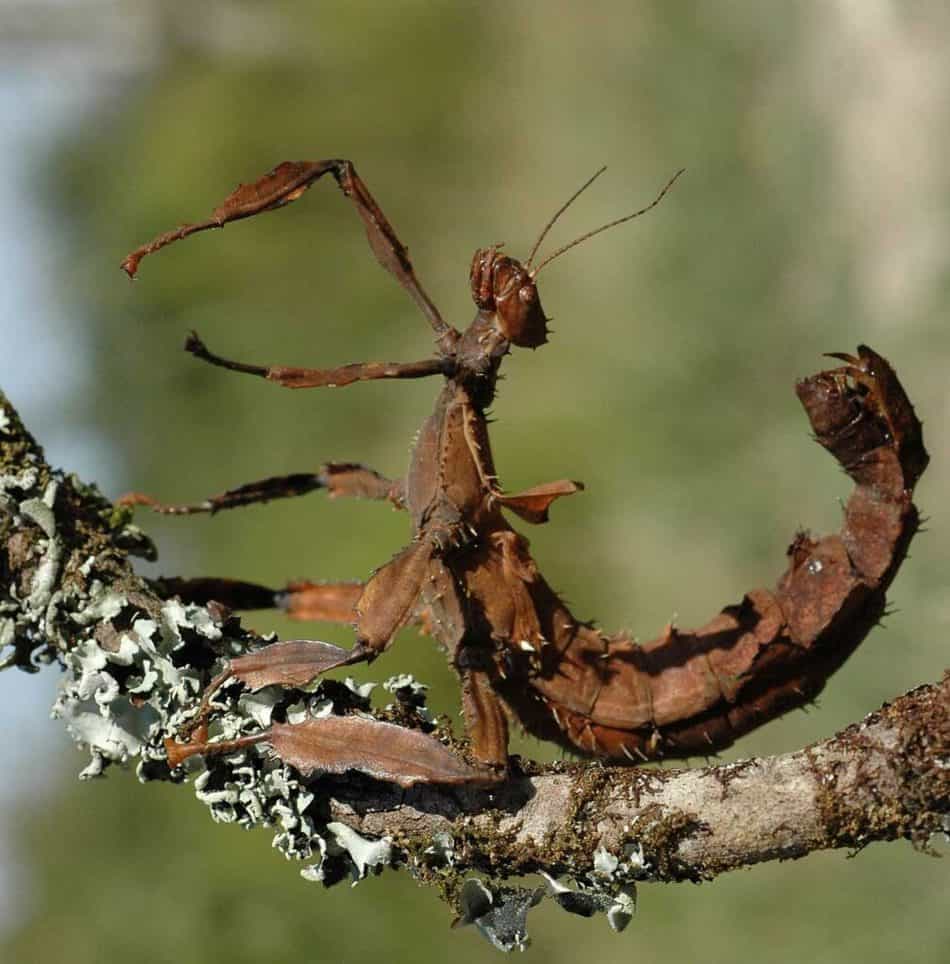
As the female is quite large and carries lots of eggs, she is unable to fly, but the male has strong wings and is adept at flying. To protect itself from predators, the giant prickly stick insect has thorny spikes on its back legs, which it uses to snap and catch. When under threat, the giant prickly stick insect will raise its back legs to mimic a scorpion . Most predators will retreat but those that do not run the risk of suffering an attack by its thorny back legs.
. Most predators will retreat but those that do not run the risk of suffering an attack by its thorny back legs.
Giant Spiny Stick Insect
The giant spiny stick insect is also known as the Spiny Devil, the Papua New Guinea stick insect, or Eurycantha calcarata. It comes from from Papua New Guinea and they make great pets due to being a hardy species.
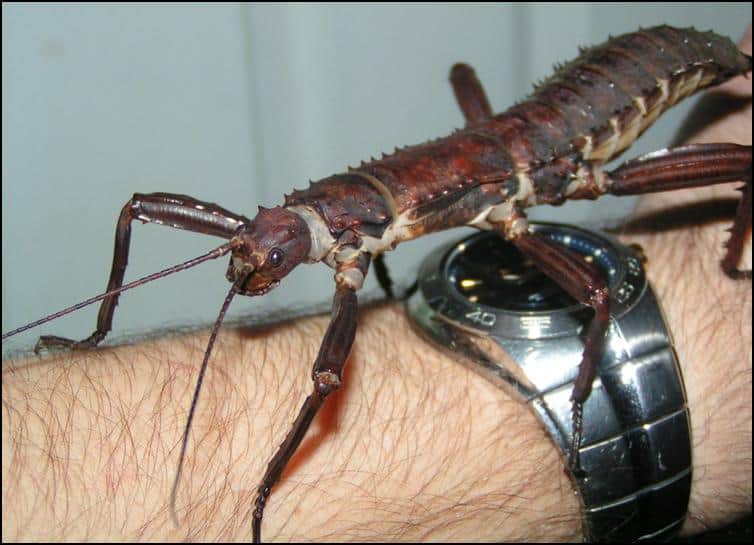
It ranges in colour from brown to pale green and uses camouflage to avoid detection; it resembles rotten wood or bark. Neither the male nor the female has wings, but they do have spines on their body and legs to protect themselves. As with most stick insects, the male is smaller than the female. The male tends to grow to around 12cm in length while the female will reach around 15cm. Although not poisonous, the giant spiny stick insect uses its thorny armour to escape predators; however, it prefers to avoid detection in the first instance, often feigning death by going rigid if under threat.
The Walk Bean
The walk bean (Diapherodes gigantea) originates in the Caribbean. The female can grow to 16cm while the male typically reaches around 11cm in length. The female is characteristically a bright green in colour while the male is brown with green spots. The female also has a row of pink spines on the back legs while she has wings that are undeveloped. The male has both fore and hind wings but is unable to fly. It can, however, make long jumps. When under threat, this stick insect jumps away; this is its only form of defence.
away; this is its only form of defence.
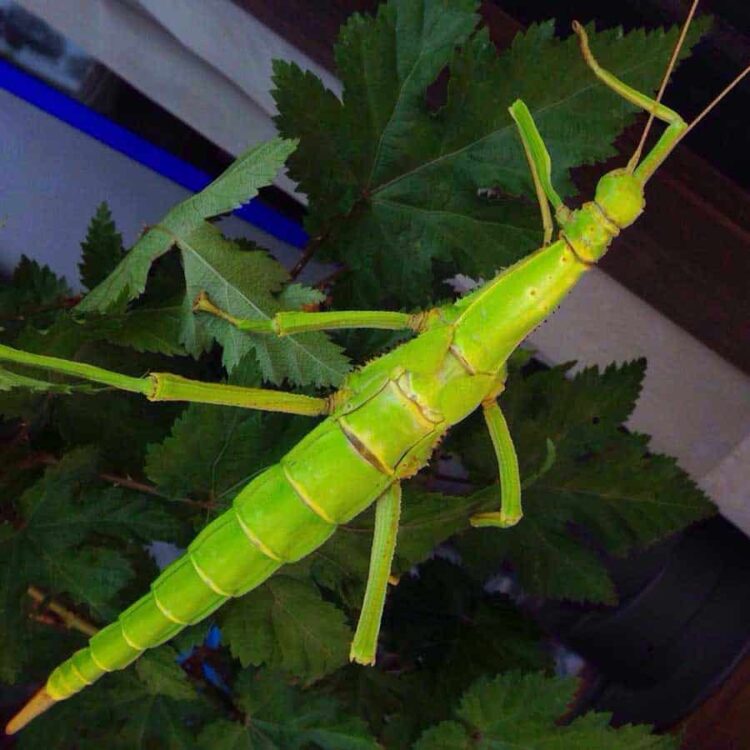
Black Beauty
The black beauty is also known as Black Velvet or Peruphasma schultei. It comes from northern Peru and, as the name would suggest, is mainly black colour. It does, though, have bright red wings, but it cannot fly.
The female tends to grow to around 7cm while the male is smaller at around 5cm. They are a popular pet due to their unique appearance. However, when asking the question are stick insects poisonous, you need only look at black beauty. This is one type of stick insect that does have the ability to poison predators.
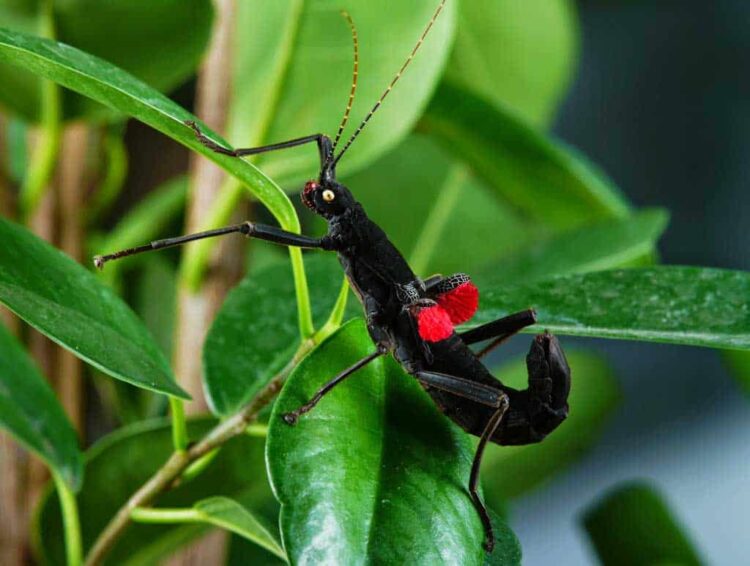
If under threat, black beauty can spray a chemical from glands behind its head. This spray can irritate skin and eyes and when deployed in the wild allows the stick to escape. As a pet, it is recommended that only experienced owners consider this species.
Warning: The black beauty stick insect is not recommended for newbie stick insect owners or children due to a chemical it produces that can irritate the skin.
Jungle Nymph
The jungle nymph is a species of stick insect that is different from what most people expect. The female is bright green and very big with a wide body. Males are brown and lengthy with long wings that extend the length of their bodies. As a nocturnal insect, the jungle nymph will usually be very quiet during the day.
This type of stick insect can hurt you if it feels threatened. The female will raise up on her front legs and will keep her back legs in the air. If you then try to touch her, she will snap her back legs together. As her back legs are covered with large spines, there is the chance that she could draw blood from your hand or any fingers she traps.
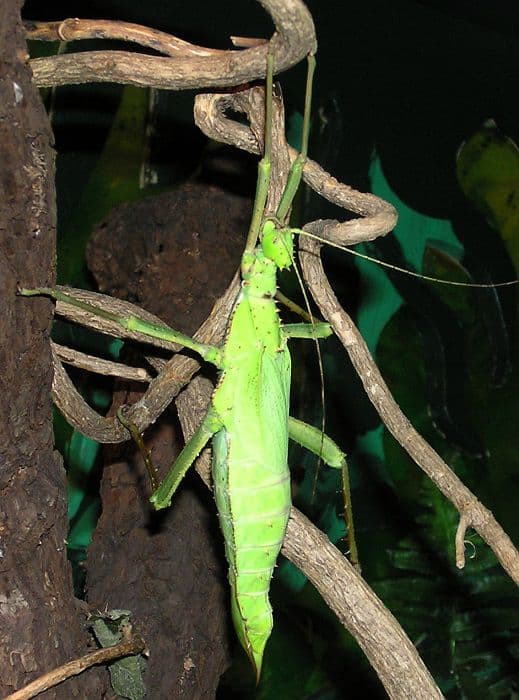
Female jungle nymphs may also make a loud rustling noise with their wings to deter any predators. It is not recommended that the jungle nymph be kept as a pet for children because of the way in which they defend themselves.
Warning: The jungle nymph stick insect can prick little fingers, so they are not recommended for children.
Vietnamese Stick Insect
The Vietnamese (Annam) stick insect is long and thin and look like what most people expect from a stick insect. The adult females have a small thorn on their abdomen. This type of stick insect is harmless but very fragile, particularly the nymphs. In order to protect itself, it will walk in a wobbly fashion so that predators assume it is a twig blowing in the wind rather than something that can be eaten.
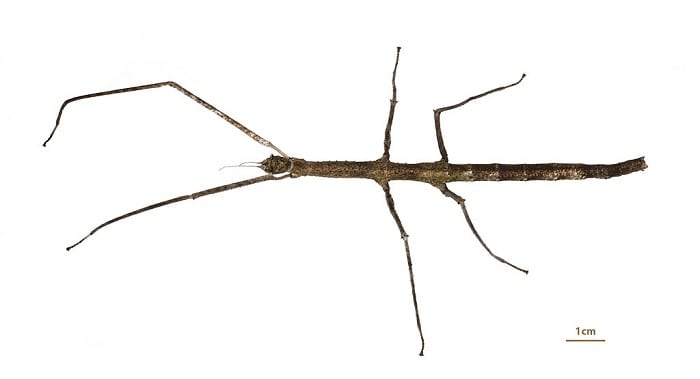
Vietnamese stick insects are not aggressive and tend to protect themselves by way of camouflage rather than aggression. They may also play dead so as not to attract the attention of predators.
Thorny Stick Insect
The thorny stick insect looks like a spiky stick. The male of the species tends to have very large spikes, but these spikes are not used for stinging or fighting; they are instead intended to make the stick insect harder to eat.
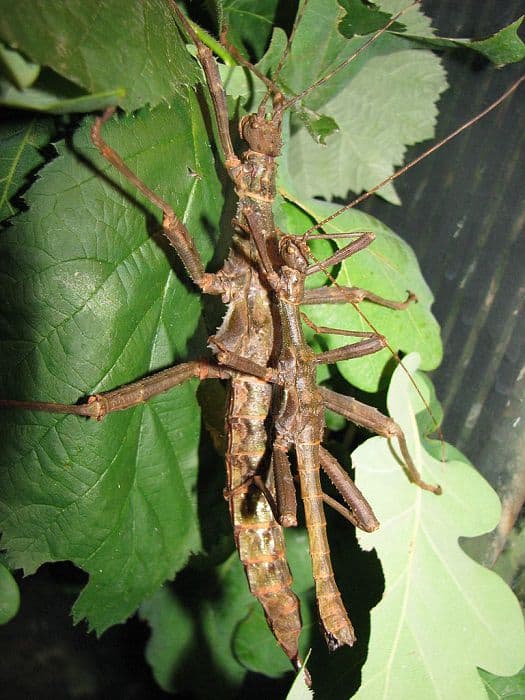
New Guinea Spiny Stick Insect
The New Guinea spiny stick insect is large and bulky, resembling a small branch rather than a twig or stick. It is dark brown in colour and sometimes looks black. The male of the species is often aggressive towards other males, so if it is kept as a pet, ensure that there is enough space for the males to avoid each other.
When threatened, male New Guinea spiny stick insects stand on their front legs, lifting their back legs that they will then use to defend themselves. These stick insects can trap your fingers or hands if they feel under threat, so it is wise to keep them away from children.
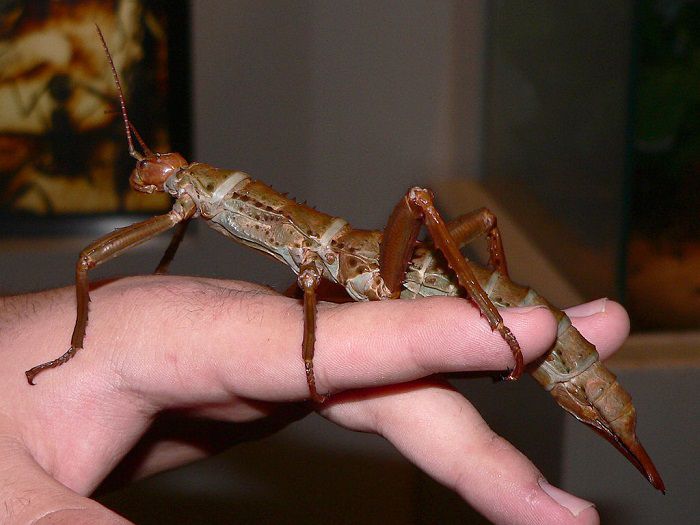
Southern Two-Striped Stick Insect
The Southern two-striped stick insect, or ‘devil rider’ as it is also known, will deploy a chemical spray when under attack. They use this spray to stop predators; because of this they should only be kept by experienced insect keepers. The spray is a strong-smelling substance that can be squirted up to fifteen inches. It can cause severe pain, particularly if it gets into the eyes (potentially causing vision problems that last for up to five days).
Warning: The southern two-striped stick insect produces and deploys a chemical compound that can irritate, especially the eyes. These are not recommended for newbie owners or children.
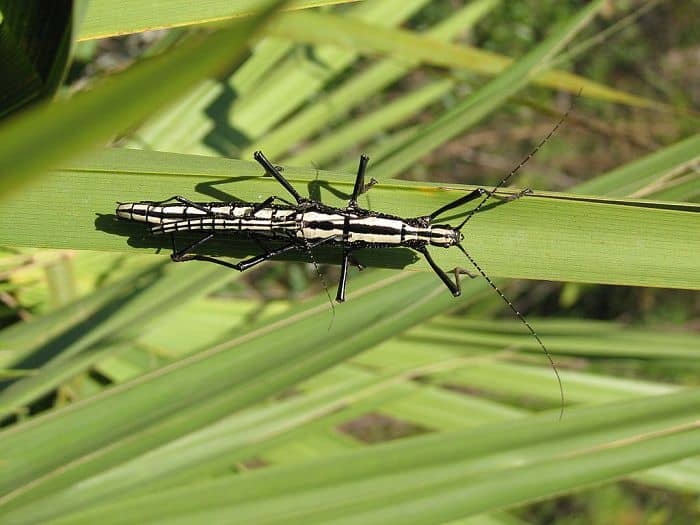
Stick Insects as Pets
As mentioned before, stick insects can make wonderful pets. With thousands of species to choose from, you will certainly be spoiled for choice. But if you are a first timer, it is advisable to choose one of the easier species to get you started.
The Indian stick insect is the most common type of pet because it will give you an idea of what is involved in taking care of these creatures. To look after a stick insect, you will need some basic equipment. This will include a container or tank in the first instance. When choosing an appropriate tank, you need one that is well ventilated but that will not allow the creatures to escape. It is recommended that you choose a tank that has a mesh screen at the top.
Your tank should be at least three times as high as the length of the adult stick insect (I recommend more than this, if possible) as this allows for easier molting. Stick insects shed their skins a number of times before becoming adults and usually hang from high up when doing this. Amazon has a great selection of stick insect enclosures if you are interested. You can see these by clicking here
a number of times before becoming adults and usually hang from high up when doing this. Amazon has a great selection of stick insect enclosures if you are interested. You can see these by clicking here (opens in a new tab).
(opens in a new tab).
You will also need to buy a mister to keep the tank humid. It is important that you spray the tank regularly as a warm, humid environment is necessary and allows for easier shedding of skin. Other than that, you will not need much else for an Indian stick insect. Nonetheless, if you did want one of the more exotic species of stick insect, you would likely need to invest in a heat bulb or heat mat to achieve the desired ‘tropical’ temperature that the stick requires. Amazon has a good selection of these as well. Click here to take a look (opens in a new tab).
to take a look (opens in a new tab).
Feeding Stick Insects
Feeding stick insects is easy thanks to the fact that they are herbivores and only eat fresh leaves. Stick insects are also clever enough to avoid any plants that are toxic to them. Having said that, you do need to ensure that you place food that they like in the container. No matter how hungry your stick insects are, they will not eat plants that they do not like (which can lead to starvation).
In general, Indian stick insects like to eat fresh bramble and privet leaves. They do also enjoy leaves from rose bushes, ivy, hazel, hawthorn, and oak. You can collect their preferred food source from parks or woodlands, or you may even have some growing in the garden.
and privet leaves. They do also enjoy leaves from rose bushes, ivy, hazel, hawthorn, and oak. You can collect their preferred food source from parks or woodlands, or you may even have some growing in the garden.
Whatever type of plant you use to feed your sticks with, it is important to wash it beforehand as there is a chance of chemical residue from passing vehicles sitting on the leaves; this can be harmful for the sticks.
Place the fresh leaves in the tank, with the stem sitting in a container of water as this will keep it fresher for longer and reduce the need to change it every day. If you cut the stem at an angle, it will make it easier for it to absorb the water and keep the food source fresher for longer. Remember, stick insects like older leaves rather than young leaves so look for fresh, dark green leaves and they will be happy.
Photo Credits:
- Indian Stick Insect: flickr.com/photos/ajc1
- Giant Prickly Stick Insect: pixabay.com/en/users/ddouk
- Giant Spiny Stick Insect: onathansjungleroadshow.co.uk/meet-the-new-guinea-spiny-stick-insects.html
- Jungle Nymph Stick Insect: Arpingstone
 – public domain
– public domain - Vietnamese Stick Insect: Jacek Halicki
 – CC BY-SA 4.0
– CC BY-SA 4.0 - Thorny Stick Insects: Drägüs
 – CC BY-SA 3.0
– CC BY-SA 3.0 - New Guinea Spiny Stick Insect: Greg Hume
 – CC BY-SA 3.0
– CC BY-SA 3.0 - Southern Two-Striped Stick Insect: Bugenstein
 – CC BY-SA 3.0
– CC BY-SA 3.0

